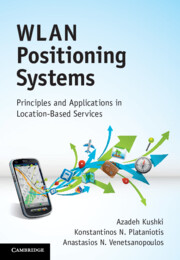9 - System design considerations
from Part II - Signal processing theory
Published online by Cambridge University Press: 05 February 2012
Summary
In the previous chapters, we addressed the problem of position estimation given values of received signal strength (RSS). In this chapter, we focus on the architectural and system design aspects of a positioning solution.
We begin by outlining the five design issues that must be considered in WLAN positioning systems (Section 9.1). We then proceed to discuss architectural details of three functional modules of positioning systems, namely sensing, computation, and storage (Sections 9.2, 9.3, 9.4, and 9.5).
Design issues
Before proceeding to a discussion of the design of an RSS-based positioning system in detail, let us provide an overview of five key design challenges in these systems.
Limited communication bandwidth
Communication via wireless channels imposes severe limitations on the available band-width (5 and 11 Mbps for an IEEE 802.11b wirelessLAN[81]). This is due to the intensity drop as a function of the fourth power of the distance, the presence of obstructing objects (shadowing effects), and multipath fading [69]. As a result, RSS-based positioning systems must be designed in such a way as to minimize the number and frequency of wireless communications.
Distributed operation
Because communication is much more expensive than most processing operations, it is highly desirable for the processing to take place in a distributed manner to reduce traffic volume and energy costs [69]. Also, in large environments, access and anchor points are distributed over a large geographical area.
- Type
- Chapter
- Information
- WLAN Positioning SystemsPrinciples and Applications in Location-Based Services, pp. 127 - 135Publisher: Cambridge University PressPrint publication year: 2012



